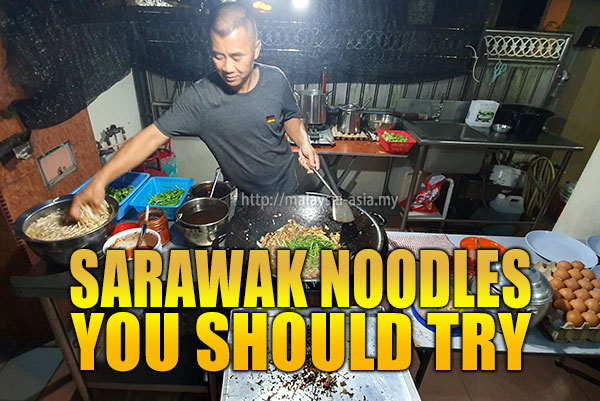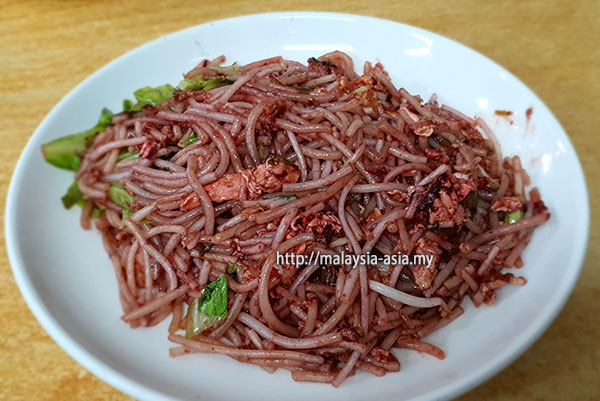When you visit the Land of the Hornbills in Borneo, food is undoubtedly one of the things to explore, and here are 13 Sarawak noodles you have to try when you are there.
Most visitors will start in Kuching, the capital of Sarawak, and the adventurous will travel north towards Sibu and then to Miri.
There will be many opportunities for you to sample some of the best local Sarawak food along the journey. Among them, some of the more unique Sarawak noodles are highly recommended.
If you notice, I am not naming restaurants or hawkers for most of them. When you are in the cities or towns, you can look out for them at various coffee shops, hawker centres, cafes, restaurants or even at some hotels.
Below is the list of unique, exciting and different noodles to explore while in Sarawak.
13 Sarawak Noodles You Have To Try
 |
| This Kolo Mee is unique, with everything added inside. |
1. Kolo Mee
This is undoubtedly one of the most famous Sarawak noodles literally found anywhere in and around Sarawak, from villages to towns to big cities.
Kolo Mee is an egg noodle served dry, in soup or even fried, and sold more commonly by the Chinese community.
However, due to this noodle's popularity, you can even find Halal versions of Kolo Mee sold at some Malay hawker stalls or restaurants.
Kolo Mee is predominantly served with roast pork slices known as Char Siew, but the meat is replaced with chicken or beef pieces for a Halal or pork-free version.
The price varies from RM3.00 to RM6.00 a bowl, depending on where you eat them in Kuching. In the main cities, prices are obviously a little higher than in the smaller towns or villages.
Some of these hawkers have also taken the liberty to offer Kolo Mee Special, where they include many other ingredients like innards, prawns, etc.
 |
| Sarawak Laksa, one of the world-famous noodles |
2. Sarawak Laksa
After gaining worldwide attention from the late Anthony Bourdain, who visited Kuching and sampled this local favourite, more people know about the famed Sarawak Laksa dish.
While many will debate where to find the best Sarawak Laksa, I leave it up to the consumer's judgment, not based on one person's judgment.
To be very honest, Sarawak Laksa's taste varies from stall to stall. After years of visiting Sarawak and speaking to many locals, each has its own favourite laksa stall or restaurant.
And do not be easily fooled to think that you can get a good bowl of Sarawak Laksa in Kuala Lumpur, as it is not the same thing. It is like comparing the Sabah Laksa with the Sarawak one.
 |
| Sarawak Dry Laksa or Laksa Kering |
3. Laksa Kering (Dry Laksa)
This one is rather special and different as it is a dry version of the famed Sarawak Laksa. Yes, a completely dried version like the typically dried noodles we order.
While it has been done several times before, it never really took off as Laksa is Laksa and most people agree that it should always be soup-based.
So, one fine day while I was staying in the Padungan area of Kuching, I ventured around here and ended up in a local coffee shop and noticed a stall promoting the Laksa Kering or Dry Laksa.
Without hesitation, I ordered a bowl to find it attractive compared to the original. The mixture base is the Laksa sauce cooked until a dried paste.
The noodles are then served with the dry paste at the bottom, and all you need to do is mix them together, and you have your Laksa Kering.
If you are in Kuching, head over to Restoran Taipan Corner in Padungan and look for the Laksa stall in the coffee shop's front.
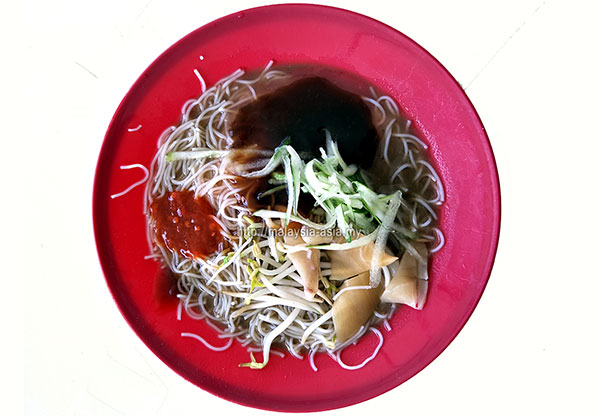 |
| The 'Oh-so-unique' Mee Belacan from Kuching |
4. Mee Belacan
This has become one of the most unique noodles that I have tried in Sarawak and possibly in all of Malaysia. A noodle that is complimented with a special belacan sauce, which is out of this world.
Firstly, belacan is a fermented shrimp paste and is an acquired taste for Malaysians. With that, not many people can accept this dish, including me.
The noodle is boiled and then complimented with a clear soupy belacan flavoured soup with fresh cuttlefish pieces and vegetables.
On top of that, belacan paste is added to the dish to boost the flavour, which totally blew my mind. I have only tasted the Mee Belacan twice and never again.
But I swear that some local Sarawakians love this special dish, which can be found in the Padungan area of Kuching. Trust me, this Mee Belacan is totally an acquired taste and not to be messed with.
 |
| Mee Dawai, a local favourite in Sarawak |
5. Mee Tomato (Mee Dawai)
As the locals call it, another of Kuching's local favourites is the Tomato Noodles or mee tomato. Some even nicknamed this dish mee dawai or wire noodles due to its outcome after being served.
The Mee Tomato is a simple dish with its origins in the popular Cantonese noodle dish of Kung Fu Chow. Only the sauce is replaced with a strong tomato-based thick gravy.
The noodles are first deep-fried, and then the tomato gravy is cooked with chicken or pork pieces and then poured over the deep-fried noodles before serving.
You can find Mee Tomato at most hawker centres or some restaurants around Kuching and other cities or towns in Sarawak.
Is it nice? Being Malaysian, this dish is easily accepted due to the similarities of the Cantonese noodles and the sweet and sour dishes, so I recommend trying this in Sarawak.
The trick to getting a good plate of Mee Tomato lies in the gravy or sauce, as it should be a balanced thickness, not too watery or too thick.
As the locals call it, another of Kuching's local favourites is the Tomato Noodles or mee tomato. Some even nicknamed this dish mee dawai or wire noodles due to its outcome after being served.
The Mee Tomato is a simple dish with its origins in the popular Cantonese noodle dish of Kung Fu Chow. Only the sauce is replaced with a strong tomato-based thick gravy.
The noodles are first deep-fried, and then the tomato gravy is cooked with chicken or pork pieces and then poured over the deep-fried noodles before serving.
You can find Mee Tomato at most hawker centres or some restaurants around Kuching and other cities or towns in Sarawak.
Is it nice? Being Malaysian, this dish is easily accepted due to the similarities of the Cantonese noodles and the sweet and sour dishes, so I recommend trying this in Sarawak.
The trick to getting a good plate of Mee Tomato lies in the gravy or sauce, as it should be a balanced thickness, not too watery or too thick.
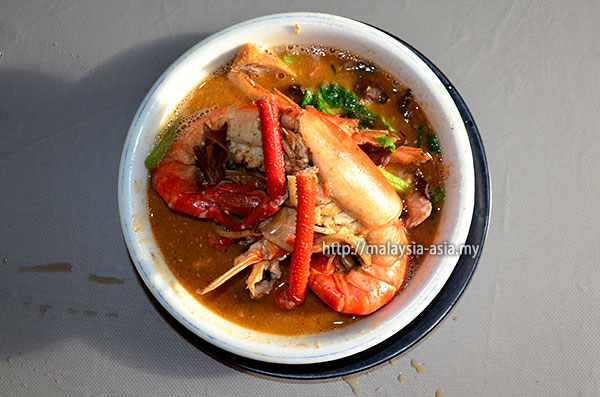 |
| The lobster noodles in Foochow style |
This noodle got me all excited, as seeing a river lobster or Udang Galah in a bowl of noodles is beyond our usual expectations.
Only in the city of Sibu in Sarawak will you chance upon this at a local coffee shop, and it is known to be a typical dish here.
Sibu is home to many Foochow people, and trust me, the Foochow people really know how to cook noodles. During a trip there, I was introduced to many different types of Foochow dishes, and this Udang Galah noodle was something I was totally fascinated with.
One of the local restaurants had this on the menu, and the price was based on the size of the river lobsters; on average, a bowl of this can cost anywhere from RM20 to RM40.
While that may be quite pricey for some, trust me if you are a visitor here, you have to splurge on this local favourite as the way it is cooked, and the sheer freshness of the river lobster brings this dish to another level.
You can find the Sibu Lobster Noodles around the main city area, specifically at local Chinese coffee shops or restaurants. It is best to go with the locals too.
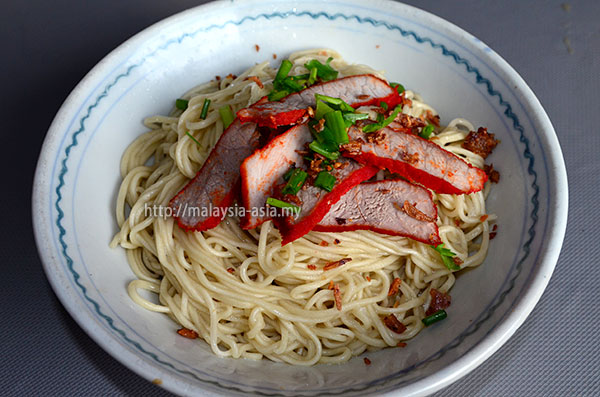 |
| One of the well-known Kampua Noodles in Sibu |
7. Kampua Noodles
One of the more popular Foochow noodles is the Kampua noodles, found all over Sibu city in central Sarawak. However, in places like Kuching or Miri, you can still find them, but very few places sell this.
If you are looking for a famous Kampua noodle, you most likely have to visit Sibu to try this. While I am still on my journey to try more of these Foochow noodles, I will probably get more information by 2021.
One of the more popular Foochow noodles is the Kampua noodles, found all over Sibu city in central Sarawak. However, in places like Kuching or Miri, you can still find them, but very few places sell this.
If you are looking for a famous Kampua noodle, you most likely have to visit Sibu to try this. While I am still on my journey to try more of these Foochow noodles, I will probably get more information by 2021.
Also, a few so-called famous Kampua Noodles are found in Sibu, so the challenge is for me to look for them.
 |
| Kway Chap in Kuching |
This is probably every meat lover's favourite, but finding the best Kueh Chap in Kuching is considered not easy. I have tried a few, and most of them are just average, but then again, what is normal?
For a good bowl of Kueh Chap, one needs to contact a local foodie who knows where the good ones are located. Over the years, I have met many locals who have given me a different place.
To date, the only acceptable and pleasant Kuey Chap is still at the Temple Food Court on Carpenter Street in Kuching. The price is not that cheap, but it is quite good on average.
 |
| Mee Cangkuk Manis is usually mee hoon noodles |
9. Mee Cangkuk Manis
This is one of the more challenging dishes to find due to a lot of work to prepare this dish, and Cangkuk Manis noodles are worth hunting for when you are in Sarawak.
This is one of the more challenging dishes to find due to a lot of work to prepare this dish, and Cangkuk Manis noodles are worth hunting for when you are in Sarawak.
Often called Sayur Manis, this vegetable noodle is usually fried with mee hoon or fine rice vermicelli and can be found at specific night markets or even coffee shops.
However, the taste varies from place to place; some simply fry it for the sake of selling, and others passionately do this as a local favourite.
And the worst part is I cannot even list down one place where you can get a decent plate of Mee Cangkuk Manis in Kuching. Maybe someone can help me out here.
 |
| A Halal version of the Kolo Mee Goreng in Kuching |
With Kolo Mee being a popular dish, it is only fair that there is a fried version of this, and there are many places that offer this option around Sarawak. Well, it's not super popular, but you can still get them at food courts.
Over the years of exploring Sarawak, I noticed that the Kolo Mee Goreng is commonly found among Malay food vendors. One of them is at Damai Central, just in front of the Sarawak Cultural Village.
The method is clearly straightforward, where they use the Kolo noodles to fry it, similar to a fried noodle style or Mee Goreng.
Condiments are similar to fried Maggi or Indomee, but the noodles make it slightly different, and if you're lucky, you can ask to add some Dabai into it.
All over Sarawak, you will easily find Foochow people, and when you find them, there will always be unique Foochow food available.
Among the popular Foochow food, the Foochow Noodles seem to get much attention from locals and tourists.
Some of the Foochow Noodles are so interesting that they often taste out-of-this-world, especially with the type of cooking wine used.
Overall, there are so many Foochow Noodles that it is hard to narrow them down; hence it is best to visit a Foochow restaurant or coffee shop and try them individually.
One of the recommended places is Mee Kwong Cafe in Kuching, and they serve a mean menu of Foochow dishes here.
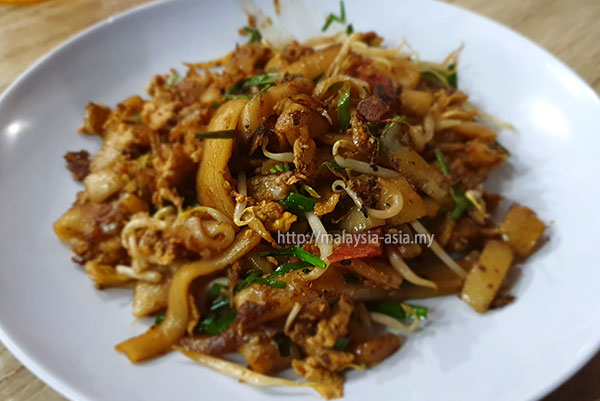 |
| Marudi Kuay Tiaw or Kuey Teow |
12. Marudi Kuay Tiaw (Kuey Teow)
This is one dish that I totally went crazy for, not only because it is so hard to find but also because it is so normal but different.
Marudi Kuay Tiaw is not easy to find because it is not something familiar that you can locate in Miri, Sarawak. Only the locals seem to know where to get this unique dish.
Of course, if you visit the town of Marudi in Sarawak, you will have the opportunity to experience the Marudi Kuay Tiaw first-hand, and that apparently is the best.
So, what makes this dish special? It is the thickness of the flat rice noodles, and it is double what we are used to. Imagine this dish with much thicker flat kuay teow noodles.
My mission is to visit Marudi to try this, and the one in the photo above is actually taken from a house stall in Miri City.
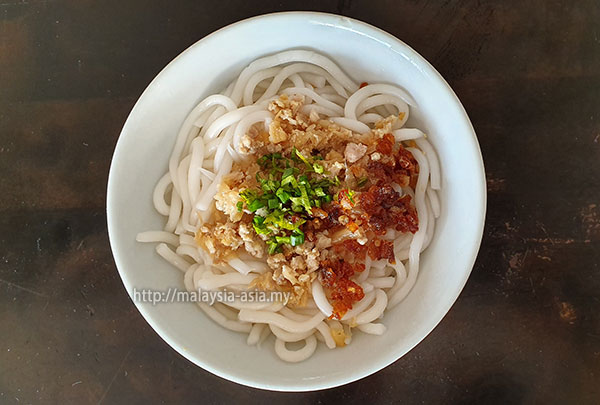 |
| The 75-year-old handmade noodles in Miri |
13. Lo Shu Fen Miri (Loh Shi Fun)
Famous in Miri and known only to locals, this noodle is called Lo Shu Fen or Loh Shi Fun and is hand made rice noodle with a 75-year history.
The family that runs this shop is now in the third generation and does not seem to stop soon. The quality of the noodles is supreme because it is still handmade.
The family has moved from their humble beginnings of a stall and a shop lot in the Pujut area of Miri, Sarawak.
 |
| A typical menu is seen at a local Foochow stall in Kuching. |
Conclusion
For the record, I have also done a specialised Kuching food review using a Galaxy Note 10 Plus in 2019, and it features some of the more unique foods around Kuching.
The above is a collection of real-time experiences by me after exploring Sarawak in the recent years of my travels.
I have gone upriver into the interiors and explored many smaller towns and villages, yet there is still more to explore.
During my exploration, I always make it a point to try out the local food from each area; hence I came out with this article on 13 Sarawak noodles you have to try.

